Last updated: December 13, 2017
Place
Kennedy Farm

John Brown had long been a fanatic abolitionist and a deeply religious Christian. As early as 1847, he had developed a plan for the forcible liberation of enslaved people. With his family's assistance, Brown organized resistance to the Fugitive Slave Act of 1850, which deprived runaways of legal rights and imposed harsh penalties on those who aided them. In 1855, Brown moved his family to Kansas in response to the Kansas-Nebraska Act of 1854, which stipulated that settlers to the territory could vote to determine if the state would enter the Union as a slave state or a free one. He began to violently defend his cause. One year later, he would rise in notoriety for the revenge slaying of five pro-slavery men.
Brown's ultimate plan was to establish a sort of fugitive slave republic in the mountains of Virginia or Maryland. With good armed defense, he hoped, this refuge might maintain itself against attack. He believed that what he needed was a bold stroke that would startle the nation to action, draw adherents to his cause, and leave no room for compromise. That striking action was to be a raid on the federal arsenal at Harpers Ferry and the capture of the town.
Along with a small band of followers, he rented the two-story Kennedy farmhouse, located approximately seven miles from Harpers Ferry. During the three months leading up to the raid, Brown divided his time between Chambersburg, Pennsylvania and this farm, living under the alias of Isaac Smith, a cattle buyer from New York. The Kennedy farmhouse served as the center of operations where Brown stockpiled weapons and studied local maps. He stored 15 boxes of guns and hundreds of pikes to arm future liberated enslaved recruits from the Virginia countryside.
Twenty-one men gathered at the farm in preparation for the attack just across the Potomac River. To not alarm neighbors, the men hid in the attic during the day and only emerged after dark. Brown’s family helped keep appearances by tending to the farm and household duties.
On October 16, 1859, Brown’s small band seized the Harpers Ferry armory and took several hostages. The following day U.S. Army Colonel Robert E. Lee arrived with a company of Marines and cornered Brown and his men in the armory's engine house. Brown eventually surrendered. By the end of the altercation, eighteen people had died—two enslaved people, three townsmen, one Marine, and ten of Brown’s men. A free black man named Heyward Shepherd, who worked for the B&O Railroad, was also killed. Brown was brought to trial in Charles Town (now West Virginia) for insurrection against the State of Virginia. The court found him guilty and he was hanged on December 2, 1859.
Although the three-day raid failed to gain him recruits or liberate enslaved people, Brown’s insurrection further deflated the possibility of a peaceful settlement of the American slavery issue. Brown accelerated the polarization between pro-slavery advocates and abolitionists and intensified the inevitability of violent conflict between the North and South. Less than two years after the raid planned at Kennedy Farm, the country would erupt in civil war.
National Historic Landmark Nomination of Kennedy Farm
National Historic Landmarks (NHLs) are historic places that possess exceptional value in commemorating or illustrating the history of the United States. The National Park Service’s National Historic Landmarks Program oversees the designation of such sites. There are just over 2,500 National Historic Landmarks. All NHLs are also listed in the National Register of Historic Places.
